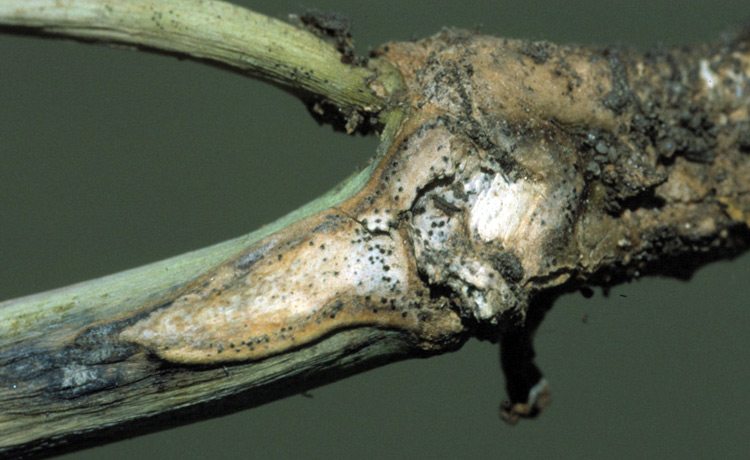Experts say growers need to deploy a multi-pronged management approach.
_x000D_
From the Prairies to Western Canada, the prevalence of blackleg is gaining the attention of growers, agronomic advisers, retailers, seed companies, governments and trading partners. The government of Manitoba reports that blackleg is becoming an increasing problem on the Prairies, with losses up to 50 per cent having been recorded in fields where susceptible varieties of canola were grown. During the past 10 years, growers in Western Canada have also witnessed this same trend, according to Curtis Rempel, who serves as the vice-president of crop production and innovation for the Canola Council of Canada (CCC)._x000D_
_x000D_
Severity is dependent on a number of factors, including geography, weather and cultivars grown. The disease, caused by the pathogen Leptosphaeria maculans, is also problematic in Australia and Europe._x000D_
_x000D_
An estimated average yield loss of less than 10 per cent with maximum losses of 30 to 50 per cent have been documented as a result of blackleg development in oilseed rape crops, writes Sheau-Fang Hwang, lead author of the paper Blackleg (Leptosphaeria maculans) Severity and Yield Loss in Canola, in Alberta, Canada, recently published in the journal Plants._x000D_
_x000D_
Hwang, an adjunct professor of plant pathology at the University of Alberta, goes on to says that in France, yield losses of five per cent to 20 per cent were reported in winter oilseed rape, while losses of eight to 29 per cent were documented in the United Kingdom from 1987 to 2005._x000D_
_x000D_
These types of yield losses can have a significant impact on the farm economy, especially when more than 20 million acres of canola were planted across Canada in 2016._x000D_
_x000D_
Beside the weather and geography contributing to the increase of blackleg, Rempel acknowledges that some blackleg resistance genes are no longer functional on the Prairies._x000D_
_x000D_
“The concern is that in some areas, the Rlm3 resistance may be breaking down and the corresponding isolates have become more virulent,” says Dilantha Fernando, a University of Manitoba plant pathologist._x000D_
_x000D_
Sakaria Liban, a pathologist with DL Seeds, explains that this has more to do with pathogen population. He cites a study done by researchers at the University of Manitoba showing that most of the lines in Canada are reliant on AvrLm3._x000D_
_x000D_
“Isolates that can infect this line are being selected for,” Liban says. “What’s happened over the past 10 or 15 years is that the majority of the pathogen population has shifted to be able to infect the common resistance that the Canadian varieties carry.”_x000D_
_x000D_
As such, Rempel says new resistance labels are needed to help growers identify which resistance classes might be best for their fields._x000D_
“Regression analysis shows that pod number and seed yield declined linearly as blackleg severity increased.”_x000D_
_x000D_
— Sheau-Fang Hwang
_x000D_
Blackleg Biology_x000D_
_x000D_
But once blackleg has established itself in a field, it’s hard to rid. The disease overwinters on infected canola stubble and can survive for at least two years. The blackleg fungus may also occur at low levels in the seed. Research shows that seed infection is seldom more than one to two per cent; however, this amount can introduce the fungus into new areas. The fungus is spread by rain-splashed spores, wind borne spores and by infected seed._x000D_
_x000D_
Leaf spots can occur from the seedling stage to maturity, according to information from the government of Manitoba. Whitish, round to irregular spots dotted with numerous black fruiting bodies appear on the leaves and stem in the summer. Later in the season, superficial lesions may occur at the stem base. The lesions are coloured white to grey (mild strain) or brown to greyish black (aggressive strain). The brown to greyish black stem lesions become sunken, girdling the stem near the soil line and cause premature death._x000D_
_x000D_
_x000D_
Scouting for Blackleg_x000D_
_x000D_
According to the CCC, scouting for canola blackleg is an important management tool. There are three main scouting periods for blackleg disease during the growing season. These include: prior to planting, during the vegetative stage and at swathing._x000D_
_x000D_
Prior to planting, growers and agronomists should be examining canola residue to see if pseudothecia are present._x000D_
_x000D_
During the vegetative stage, a W-pattern should be used to scout the field, starting at the edge of a field. Focus on edges where new canola residue might be present in an adjacent field. The CCC recommends examining at least 50 plants for the presence of lesions. If lesions are found on more than 10 per cent of plants, then there is risk of significant disease development._x000D_
_x000D_
At swathing is the best time to scout for the disease as the basal cankers, which cause significant yield loss are easy to see. In this stage, growers and scouts will want to pull up at least 50 plants in a W-pattern as described above. Clip with clippers at the base of the stem or top of the root and look for blackened tissue inside the crown of the stem. The amount of infection present will help identify the level of risk and the best management practices for that field in the following years._x000D_
_x000D_
Management Advice_x000D_
_x000D_
To help control and mitigate blackleg, retailers and agronomists are urged to stress the importance of using disease-free seed when working with farmers. Seed from diseased areas should be treated with a fungicide seed treatment._x000D_
_x000D_
Additionally resistant varieties are available. The use of moderately susceptible or moderately resistant varieties may still result in low levels of blackleg. Most new Argentine canola varieties are moderately resistant or resistant. However, all Polish varieties are susceptible, according to the Manitoba government._x000D_
_x000D_
Another tip to control blackleg is to incorporate infected stubble after harvest. Blackleg survives in slowly decomposing canola stubble. A four-year rotation between canola crops is recommended once blackleg has been detected in a field. Furthermore, controlling volunteer canola and wild mustard in other crops will help to mitigate the presence of blackleg._x000D_
_x000D_
Hwang says when it comes to measuring the agronomic efficacy and economic benefits of control methods, one must understand the disease-yield relationships. As such, he conducted field experiments in 2013, 2014 and 2015 to determine the relationship between blackleg disease severity and yield in a susceptible cultivar and in moderately resistant to resistant canola hybrids._x000D_
_x000D_
Based on his research, Hwang says that disease severity was lower, and seed yield was 120 per cent to 128 per cent greater in moderately resistant to resistant hybrids compared with the susceptible cultivar._x000D_
_x000D_
“Regression analysis shows that pod number and seed yield declined linearly as blackleg severity increased,” he explains. “Seed yield per plant decreased by 1.8 gram for each unit increase in disease severity, corresponding to a decline in yield of 12.7 per cent for each unit increase in disease severity.”_x000D_
_x000D_
Hwang found that pyraclostrobin fungicide reduced disease severity in all site years and increased yield. These results show that reducing blackleg substantially improves yields, he says._x000D_
_x000D_
The Multigenic Promise_x000D_
_x000D_
Seed companies and breeders continue to work in this area, providing better and better hybrids and varieties for farmers. DL Seed’s Liban says seed companies are working on introducing new types of resistance, other AvrLm genes into our varieties and into the marketplace._x000D_
_x000D_
“We’ve steadily introduced varieties that do have blackleg resistance,” Liban says, noting that this move should improve the reliability of resistance that is seen over time._x000D_
_x000D_
He says there are more than 15 resistance genes that are known._x000D_
_x000D_
“We have a lot of tools in the toolkit, per se, to be able to fight this disease,” Liban says. But he cautions that not all resistance genes are of the same quality. Liban explains that one gene may only be effective against 10 per cent of the population, whereas another resistance gene might be effective against 90 per cent of the population._x000D_
_x000D_
He says this means reasearchers have to be able to look at what’s out there in terms of pathogen population, identify which genes are most effective and then transfer those into varieties that can hit the market and help control the disease long term._x000D_
_x000D_
While there are many genes available, Liban says not many studies have been done looking at the genes in the marketplace._x000D_
_x000D_
“Over time, I expect companies will release varieties which have different sources of resistance,” he says. “Companies have already started making claims of multigenic resistance.”_x000D_
_x000D_
There’s not a single resistance gene that can overcome all the isolates in Western Canada, he says. So if you have resistance genes that are 70 per cent effective, then there’s a 30 per cent gap that some races can’t overcome._x000D_
_x000D_
“Multigenic resistance gives you the option to have a double insurance policy,” he says. “It will become harder for the pathogen to overcome multiple resistance genes. The idea is to provide different sources of resistance working together in a single variety to improve the resistance tolerance of that variety.”_x000D_
_x000D_
Continued Work_x000D_
_x000D_
The CCC has a Blackleg Steering Group, which has developed a potential model to classify blackleg resistance genes. The model would continue to support the WCC/RRC field testing to determine the categories (resistant, moderately resistant, moderately susceptible and susceptible). Major gene groupings can be determined by the breeder at their discretion. Employing genetic markers or phenotypic testing at their own facilities or at the facilities of a third party group would be up to the breeder._x000D_
_x000D_
This model is being presented and discussed at winter meetings. Rempel says he would like to achieve consensus on a new resistance classification model._x000D_
_x000D_
Once the wider industry supports a new resistance classification model, the Blackleg Steering Group will take the lead on developing extension messaging and tools for it. The wider industry can then start talking about and promoting it, with the goal to lower blackleg in the field by 2020._x000D_
_x000D_
_x000D_
_x000D_











